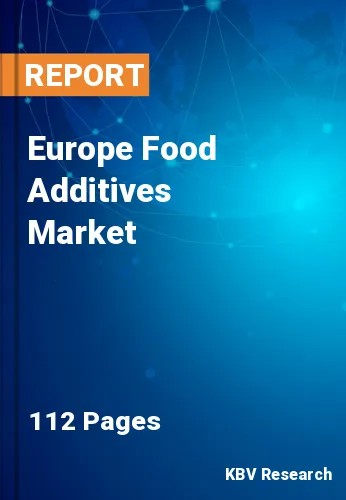The Europe Food Additives Market would witness market growth of 4.8% CAGR during the forecast period (2021-2027).
Food additives are widely used in the market due to favorable government initiatives. Some of the growth catalysts for the industry are consumer preferences for easy, processed, and packaged products, as well as changing lifestyles. In addition, they are used in little amounts in a variety of items to improve and keep freshness while also improving flavor, taste, aroma, texture, and appearance. The rise in the number of women in the workforce, as well as altering consumer lifestyle patterns, has resulted in increased consumption of processed foods. Factors such as rising urbanization and population growth would act as growth catalysts for the market in the upcoming years. Furthermore, as the supply chain becomes more challenging due to rising logistics costs, these materials are anticipated to be used to reduce wastage and spoiling costs.
Currently, the regional market is witnessing an increased demand for cakes, pastries, bread-based items, and drinks. In addition, healthy food and beverage sales are predicted to grow in Europe as the population becomes more health-conscious. Low-/no-calorie beverages accounted for a significant percentage of total soft drink sales in the United Kingdom in 2020, according to the British Soft Drinks Association. Low-calorie foods and beverages are becoming more popular in the region, which is helping to drive the market for high-intensity sweeteners, fat substitutes, and taste enhancers.
The food additive is any item not generally consumed as a food in itself and not normally employed as a distinctive constituent of food, whether or not it has nutritious value, according to the European Commission. Food additives have become increasingly important over time as a result of the different needs of the food sector, end customers, and regulatory agencies all around the world. Food additives are primarily used to give food items specific desirable attributes, improve food palatability in terms of look and appeal, ensure food safety through contamination prevention, and increase product shelf life.
The Germany market dominated the Europe Food Additives Market by Country 2020, and would continue to be a dominant market till 2027; thereby, achieving a market value of $9,022 million by 2027. The UK market is estimated to grow at a CAGR of 3.9% during (2021 - 2027). Additionally, The France market would witness a CAGR of 5.5% during (2021 - 2027).
Based on Source, the market is segmented into Natural and Synthetic. Based on Product, the market is segmented into Sweeteners, Flavors & Enhancers, Emulsifiers & Shelf-life Stabilizers, Enzymes, Fat Replacers, Prebiotics & Probiotics, Dietary Fibers, and Others. Based on Application, the market is segmented into Bakery & confectionery, Beverages, Convenience Foods, Dairy & Frozen Desserts, Spices, Condiments, Sauces & Dressings, and Others. Based on countries, the market is segmented into Germany, UK, France, Russia, Spain, Italy, and Rest of Europe.
Free Valuable Insights: The Global Food Additives Market Size will Hit $135.2 Billion by 2027, at a CAGR of 5.2%
The market research report covers the analysis of key stake holders of the market. Key companies profiled in the report include BASF SE, Kerry Group PLC, Novozymes A/S, Archer Daniels Midland Company, International Flavors & Fragrances, Inc., Ingredion, Incorporated, Tate & Lyle PLC, Ajinomoto Co. Inc., Chr. Hansen holding A/S, and Cargill Corporation.
By Source
By Product
By Application
By Country
Our team of dedicated experts can provide you with attractive expansion opportunities for your business.

